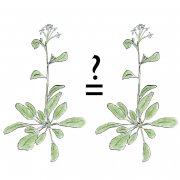How to validate the identity of genetic stocks – letter in Plant Cell
A proposal regarding best practices for validating the identity of genetic stocks and the effects of genetic variants
Bergelson, J., Buckler, E. S., Ecker, J. R., Nordborg, M., and Weigel, D.
Colleagues from the medical field have estimated that up to one third of cell lines are contaminated with other cell lines or are misidentified, and in addition, repeated passaging substantially changes cell line properties (reviewed in Hughes et al., 2007). The medical community has therefore begun to establish standards for verification of cell lines and genetic stocks, and NIH has announced efforts to require validation and to aid researchers in validating their biological material (Lorsch et al., 2014). Plant biologists should do the same. Even though the propagation of seed stocks cannot be directly compared to animal cell culture, contamination is a real possibility, and it is not uncommon that the same genetic stock produces different phenotypes in different laboratories. Confirming the genetic identity of research material is necessary to know whether such phenotypic differences reflect gene-by-environment (GxE) interactions, or whether they are simply due to apples being compared to oranges.



